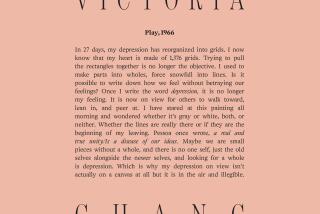Dangerously Plain
American poets often pretend that their poetry grows as naturally as weeds. Unfettered by learning, their poems light out for the territory rather than adhere to traditional forms. Poets who flaunt a knowledge of poetry seem like traitors: William Carlos Williams thought that T.S. Eliot’s footnote-laden “The Waste Land” set back the cause of American poetry by 100 years.
This anti-intellectualism is of course a pose, a pretense developed at first to combat the authority of English poets, who seemed to absorb the language of Shakespeare simply by breathing. But as the territory of American literature expanded, American poets became their own best enemy. East Coast poetry grew strong enough to seem like a tradition rather than an experiment, and West Coast poets inherited the task of rejecting book-learning and fancy forms. By the end of the 20th century, the division between the coasts was so pronounced that even a poet as subtle and learned as Ann Stanford could say that though East Coast poets are penned inside “art galleries and concerts,” she can always “cut weeds or work in the garden.”
Don’t believe her. Today, the most powerful poets of the 20th century seem to be the ones who refused to choose sides. The poems of Elizabeth Bishop, to whose example Stanford owes a great deal, are wedded neither to tradition nor to experiment; they represent a position that is not a compromise between extremes. These qualities made Bishop difficult to place during her lifetime, but since her death, she has emerged as the most esteemed American poet of the generation following Williams and Eliot. Stanford deserves a similar reevaluation: She ought to stand near her friend, poet May Swenson, just as Swenson stands near Bishop.
Whether “Dreaming the Garden,” Stanford’s posthumous volume of poems (Stanford died in 1987; “Dreaming the Garden” is her last manuscript), will be read beyond the chaparral-covered hills of Southern California is another question. During her lifetime, Stanford was, like most poets, neither well known nor neglected: Her poems appeared in The New Yorker; her books were published by Viking. Since her death, Stanford has all but disappeared, and “Dreaming the Garden” is published not by a major house but by Cahuenga Press, a cooperative operated and financed by five Los Angeles-area poets. But even if Stanford was sometimes capable of perpetuating the stand-off between east and west, it’s difficult to imagine (as her poet-publishers put it) that she built her poems “out of the very air and earth of her California landscape.” The best poems in “Dreaming the Garden” are formally meticulous but never mannered, voice-driven without seeming stagy, resolutely in the world without allowing us to forget that poetry is an artifice--a garden we do not simply tend but, as Stanford’s title emphasizes, dream.
“I have tried to tell you how it was,” begins “The Woman on the Island,” a poem in which Stanford assumes a voice in order to explain herself:
Once in a while I climbed the cliff by the shore
and watched for the ship that was sure to come.
But the years passed like leaves, where I recorded the seasons.
Notch after notch, first the moons, then the changes
from green spring to summer
to the fogs of autumn and the cold
wind bringing rain.
Still, sometimes I looked out over the sea
past the coastal shallows, where the swells
rose like the gray humps of whales
going southward in springtime.
I forgot the moons, then the seasons.
Only the years returned. I forgot the look
of the sea where it lay in its own
blue vast widening circle round the island.
These lines, at once descriptive and otherworldly, show Stanford at her best: She allows herself no emotional gestures, no flashy metaphors, not even (until the final line) any muscular rhythms. It is a poetry, as Swenson says in a letter printed as the preface to “Dreaming the Garden,” in which there appears to be “nothing artificial.” And yet the poem not only employs artificial voice to give the impression of naturalness, it is also about our need for artifice. Locked in a place where everything is “always the same,” the woman finds that merely to “record” the world is not enough: Only when she sees the world as what it is not, imagining the stationary swells as migrating whales, does the poem rise out of its superbly modulated torpor. Ultimately, the task of the woman on the island--the task of the poet--is to “forget.”
Every poem in “Dreaming the Garden” addresses our need not simply to observe the world but to change it through imaginative action. In a sequence called “Makers,” Stanford assumes the voice of a weaver whose cloth replaces the world from which it grew: “now the blue sky / dries in my yard. . . . It will tell / of the river; it will speak of the weaver.” In a sequence called “After Winslow Homer,” she describes a painting of a shipwreck in which the wreck itself does not appear: All we see is the beach, the gesturing crowd, a sky dark with storm clouds. “The event itself is what we imagine,” says Stanford, suggesting that we must conjure the true event from whatever meager evidence our senses are offered. “We could be taken in,” she continues, and the line cuts two ways: Her poem about a painting (an artifice about an artifice) may lure us into unseen emotional depths or it may deceive us. Art, for Stanford, is a dangerous enterprise--especially when it appears perfectly plain.
Stanford’s best poems are dangerously plain. As the poet James Merrill once said of Bishop, Stanford does a grand impersonation of an ordinary woman. And like Bishop, Stanford is easy to underestimate because her subtle way with artifice can make the poems seem “merely” natural. But the poems appear to ask little of us precisely because they demand a great deal of themselves. However at ease, however placid, the poems are never comfortable: They interrogate the power of artifice even as they embody it. How can the poet presume to “forget” the world when intruders threaten to trample the imagined garden of poetry?
Refugees camped here, the statues are lost
or broken. The lilies dragged from the pond
where they washed their rags and their children.
They burned the hedges for firewood
cooking thin gruel, warming their hands,
blackening the wall behind the fires.
These lines stand at the center of “Dreaming the Garden,” the long sequence of poems that gives Stanford’s book its title. Throughout these poems, the garden functions narrowly as a metaphor for poetry and more widely as a metaphor for any act of human making. “Start with the bounds,” says Stanford of the imagined garden. “You must frame the view. . . . You must keep order.”
But it is difficult to keep order when the garden is ravaged in turn by heavy rains, months of cold and finally by other people-scavengers and refugees who invade the garden’s closed circle. Stanford not only welcomes this intrusion: In a poem subtitled “Dreaming the Winter Garden,” she insists on it. At the end of one grand vista, “three dogs attack a boar”; at another, “the dogs have cornered a deer and seem to be winning.” These animals are statues--images of art turning against itself: The garden will not allow us to forget the degradation it may at first appear to elide. And even if this imagined garden bears a resemblance to the gardens at the Huntington Library, where Stanford was poetry consultant, Stanford remains committed to the forgetting rather than the mere recording of her world: “You are the garden,” she concludes, emphasizing that because we are the makers of our own lives, a world of artifice is for better and worse the only place where we can live.
“Dreaming the Garden” is the longest but not the finest poem in the book; it bears the equivocal virtue of making very clear the issues embodied more subtly in poems like “The Wreck” and “The Woman on the Island.” Though Stanford’s poems share a family resemblance with Swenson’s and Bishop’s, they sometimes lack the apparently off-handed placidity that makes Bishop’s darkest moments feel strangely uneventful--and all the more threatening. Interestingly, when Stanford edited an anthology called “The Woman Poets in English” in 1972, Bishop refused to appear: “Literature is literature,” she said, “no matter who produces it.” Bishop’s commitment to feminism could not have been stronger, but she did not want poetry to be judged in anything but the largest, most stringent terms. Stanford’s achievement is large enough to be judged by the standards set by Swenson and Bishop, poets who never forgot their origins in Utah and Nova Scotia but who refused to accept the given terms of their worlds.
Stanford lived her entire life in California, but the poems of “Dreaming the Garden” render a stationary, unchanging life as hell. They suggest that we cannot truly be said to be living if we do not imagine ourselves into locations other than the ones we might simply observe. And inasmuch as Stanford is herself “The Woman on the Island,” she refused to idealize the place where she lived--a place insufficiently ravaged by the vicissitudes of seasonal change. She dreamed boldly of a landscape where there would be “nothing but snow and silence.” Like the greatest poets of her generation, she wrote unplaceable poems.
More to Read
Sign up for our Book Club newsletter
Get the latest news, events and more from the Los Angeles Times Book Club, and help us get L.A. reading and talking.
You may occasionally receive promotional content from the Los Angeles Times.






